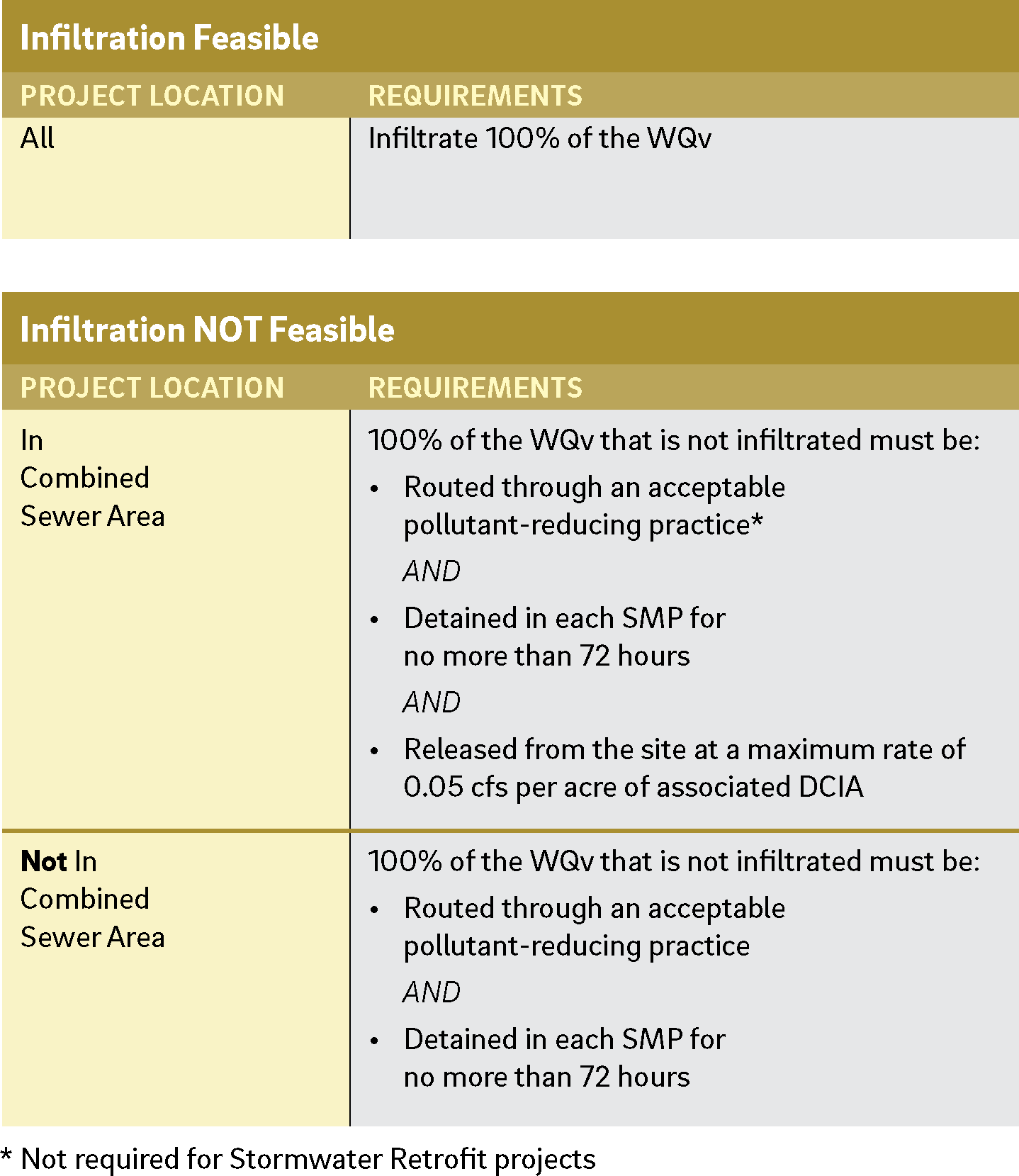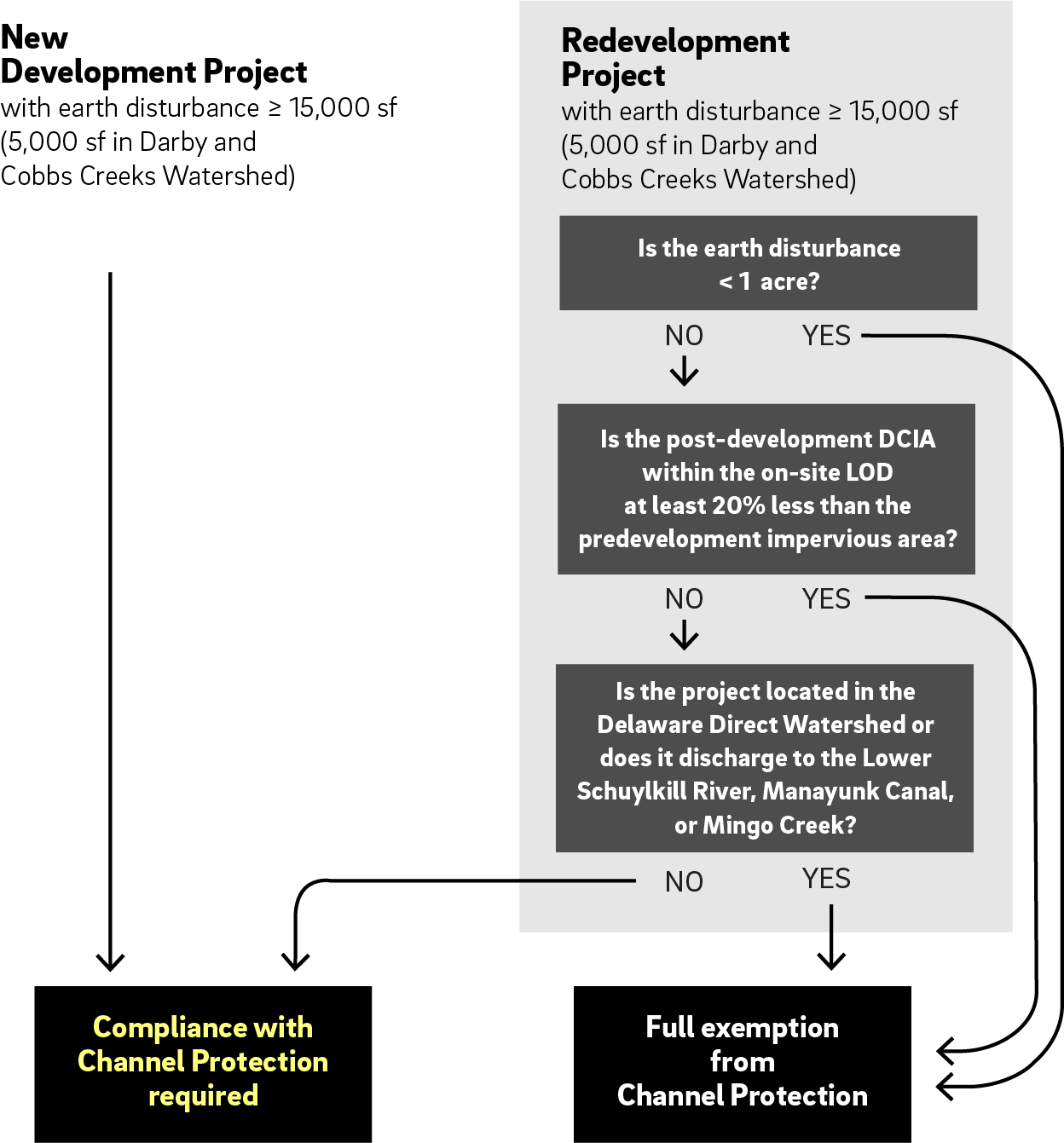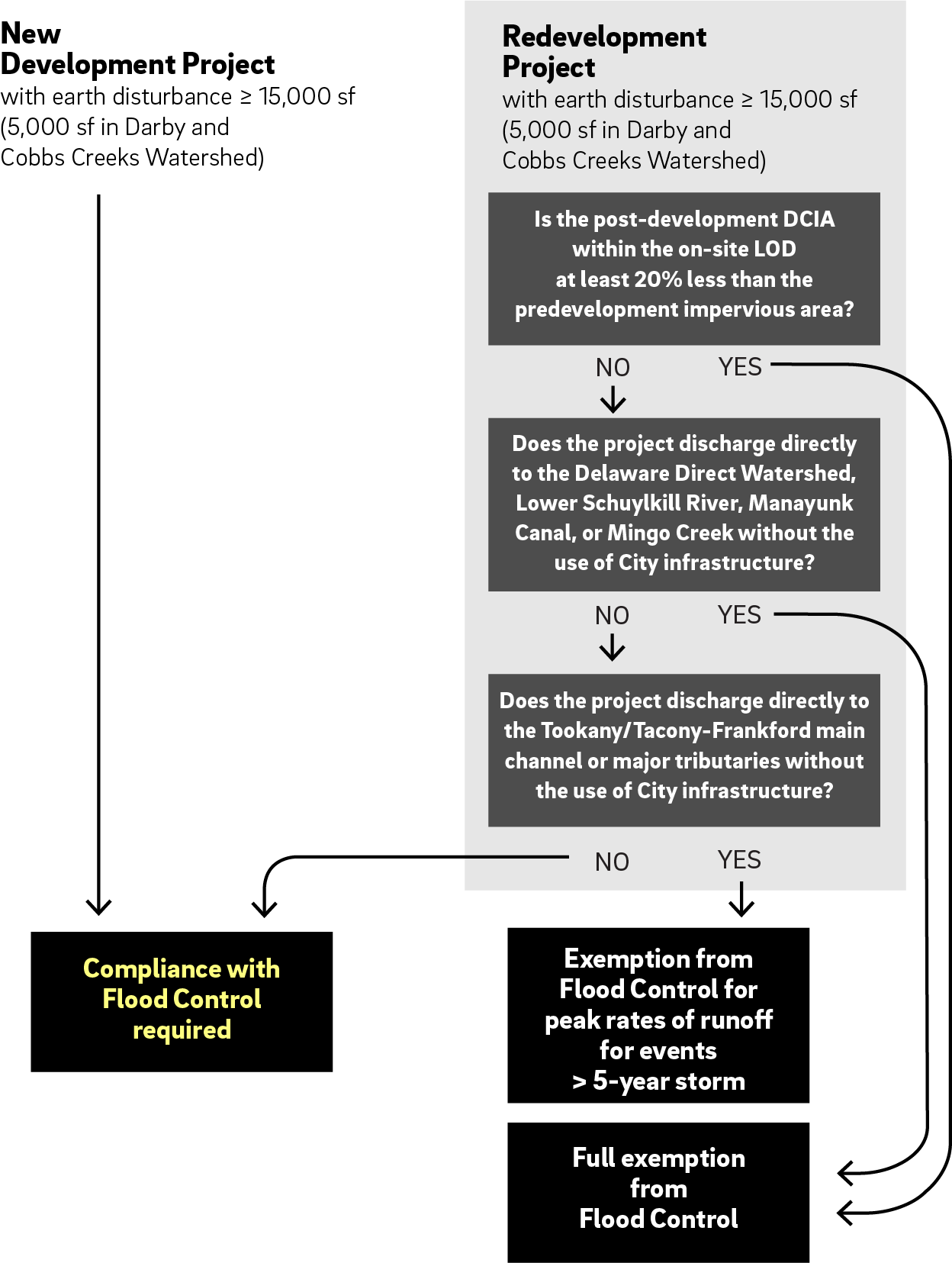This Section provides an overview of the Philadelphia Water Department (PWD) Stormwater Regulations (Stormwater Regulations), their objectives, and project-specific exemptions. After determining the project’s development type, watershed, and earth disturbance area using Section 1.1, the applicant will use this information, in conjunction with the requirement-specific exemptions detailed in this Section, to determine which portions of the Stormwater Regulations apply to the project.
The Stormwater Regulations can be found in Appendix C of this Manual. They have been developed in accordance with Philadelphia Code §14-704(3), and they consist of four major Post‑Construction Stormwater Management (PCSM) Requirements: Water Quality, Channel Protection, Flood Control, and Public Health and Safety (PHS) Release Rate. In addition, all earth disturbance activity must comply with the Erosion and Sediment Control (E&S) requirements of the Pennsylvania Department of Environmental Protection (PA DEP), as specified in 25 Pa. Code §102.4.
1.2.1 Post‑Construction Stormwater Management Requirements
PCSM Requirements regulate how stormwater runoff leaves a project site in the built or post-development condition. PCSM Requirements have four components: Water Quality, Channel Protection, Flood Control, and PHS Release Rate requirements. All projects in the City of Philadelphia that generate earth disturbance of 15,000 square feet or more, or 5,000 square feet in the Darby and Cobbs Creeks Watershed, are subject to the PCSM Requirements and will follow the Development Compliance Review Path. The applicant is referred to Section 2.1.2 for an explanation of, and further guidance regarding, Review Paths.
Water Quality
Background
The objectives of the Water Quality requirement are as follows:
- Reduce pollution in runoff;
- Recharge the groundwater table and increase stream base flows;
- Restore more natural site hydrology; and
- Reduce combined sewer overflows (CSOs) from the City’s combined sewer systems.
The Water Quality requirement focuses on the removal of pollutants from stormwater runoff and is similar to requirements in surrounding states and other major cities across the country. Water quality benefits are provided, in part, by slowing water down and allowing suspended solids to settle. Because some nutrients, metals, organics, and other contaminants are bound to these sediment particles, this basic treatment mechanism can have multiple benefits. Generally, the physical, chemical, and biological processes that take place in a system that incorporates soil, water, and plants provide the best water quality improvements.
Infiltration of stormwater runoff can significantly reduce pollutant loads reaching surface water and generally does not pose a threat to groundwater quality if there is sufficient separation from the water table. Infiltrating stormwater runoff also has a direct impact on reducing the quantity of water in the sewer system that can contribute to CSOs and pollution of receiving waters. As such, infiltration is a major focus of the Water Quality requirement.
Attenuation of stormwater flows also contributes to water quality goals. In combined sewer systems, CSOs must be reduced by maintenance of a slow release rate set to match the area-weighted wet weather treatment rate of PWD’s Water Pollution Control Plants. Therefore, when infiltration is not feasible, water quality improvement in combined sewer areas must be achieved not only by reducing runoff pollutant load concentrations, but also by managing the quantity and timing of stormwater discharge. Detention and slow release reduces peak flows in the combined sewer during wet weather events, thus reducing the frequency and magnitude of CSOs.
Requirement
The Water Quality requirement stipulates infiltration of the first 1.5 inches of runoff from all directly connected impervious area (DCIA) within the limits of earth disturbance. This volume of stormwater runoff is referred to as the Water Quality Volume (WQv). If infiltration is feasible on the project site, the Water Quality requirement must be met by infiltrating 100% of the WQv through stormwater management practices (SMPs).
One strategy to address the Water Quality requirement is to minimize the amount of DCIA, which reduces the WQv that must be treated on-site. DCIA can be reduced through the use of disconnected impervious cover (DIC), which includes green roofs, porous pavement, and rooftop, pavement, and tree disconnections, which are outlined in greater detail in Section 3.2. Projects that propose to disconnect 95% or more of their post-development impervious area may qualify for an expedited Disconnection Green Review as described in Section 2.4.
Quick Tip
Property owners often find that by incorporating landscape elements to reduce their DCIA, they simultaneously increase their property value and retail sales, reduce crime, and improve mental health and worker productivity. For more information regarding the triple bottom line benefits of green stormwater management practices, the applicant is encouraged to visit the National Resources Defense Council website.
Guidance for calculating the WQv and design requirements for DIC and SMPs can be found in Chapter 3.
If infiltration is infeasible, or where it can be demonstrated that infiltration would cause property or environmental damage, the method of compliance with the Water Quality requirement differs based on the type of sewershed in which a project is located. The applicant is referred to the sewershed maps in Appendix D to determine the type of sewershed in which their project is located. These maps are approximations of sewershed boundaries. The applicant must refer to their project’s point of stormwater discharge when determining which requirements apply to their project.
If the applicant believes that infiltration is not feasible, a waiver from the infiltration requirement must be requested via the Online Technical Worksheet (Section 3.4.3) for PWD Stormwater Plan Review approval. The applicant is referred to Section 3.3 for guidance on determining and documenting infiltration feasibility. For projects in which greater than one acre of earth is disturbed and a waiver from infiltration is requested due to soil or groundwater contamination, PA DEP must evaluate the waiver request concurrently with PWD.
Non-Infiltrating Projects Located in Combined Sewer Areas
For all areas served by a combined sewer and for which infiltration is infeasible for all or a portion of the WQv, 100% of the WQv that is not infiltrated must be routed through an acceptable pollutant-reducing practice and detained in each SMP for no more than 72 hours. 100% of the WQv that is not infiltrated must also be released from the site at a maximum rate of 0.05 cubic feet per second (cfs) per acre of associated DCIA.
Non-Infiltrating Projects NOT Located in Combined Sewer Areas
For all areas not served by a combined sewer — including separate sewer areas, direct discharge projects, and unsewered areas — for which infiltration is infeasible for all or a portion of the WQv, 100% of the WQv that is not infiltrated must be routed through an acceptable pollutant-reducing practice and detained in each SMP for no more than 72 hours. Acceptable non-infiltrating pollutant-reducing practices are listed in Table 3.1‑3.
Figure 1.2‑1: Water Quality Requirements

The applicant is referred to Section 3.4.1 for detailed information on how to demonstrate a project’s compliance with the Water Quality requirement.
There are no exemptions from the Water Quality requirement.
Stormwater Retrofit projects should be designed to meet most of the Water Quality requirement design standards. For clarification on what requirements are applicable, the applicant is referred to Section 1.3 for more information.
Channel Protection
Background
In addition to having an effect on the quality of stormwater runoff, the rate and frequency of stormwater discharge also poses a threat to the downstream environment and infrastructure. Management of peak rates from smaller storm events is referred to as Channel Protection because one of its benefits is to reduce erosive flows in downstream channels.
The objectives of the Channel Protection requirement are as follows:
- Protect the quality of stream channels and banks, fish habitat, and man-made infrastructure from the influence of the erosive forces and downstream sedimentation due to high stream velocities; and
- Reduce the quantity, frequency, and duration of CSOs.
Requirement
The Channel Protection requirement stipulates the detention and release of runoff from the one-year, 24-hour Natural Resources Conservation Service Type II design storm event for all DCIA within the limits of earth disturbance at a maximum rate of 0.24 cfs per acre of associated DCIA in no more than 72 hours.
Quick Tip
The Water Quality and Channel Protection requirements are not additive; however, management of the WQv may reduce the storage volume needed to meet the Channel Protection requirement. The designer is referred to Chapter 3 for more information on stormwater management design strategies.
This requirement applies equally to rivers, streams, and sites discharging to drainage ditches, natural or man-made ponds, and sewers that ultimately discharge to receiving waters, even if this discharge is indirect.
The applicant is referred to Section 3.4.1 for detailed information on how to demonstrate a project’s compliance with the Channel Protection requirement.
Exemptions
Projects meeting the following characteristics are exempt from the Channel Protection requirement:
- Redevelopment projects with less than one acre of earth disturbance.
- Redevelopment projects which reduce impervious area within the limits of earth disturbance (excluding public right-of-way) by at least 20%, based on a comparison of predevelopment impervious area to post-development DCIA.
- Redevelopment projects located in the Delaware Direct Watershed or that discharge to the Lower Schuylkill River, Manayunk Canal, or Mingo Creek.
- Development of new Streets and Street Maintenance Activities.
For the purposes of calculating impervious area reduction, the predevelopment impervious area is determined by the dominant land use for the ten years preceding the date of the project’s Existing Resources and Site Analysis (ERSA) Application (Section 2.1) submission. To claim a predominant land use which differs from the existing condition, the applicant must submit a predominant land use plan, in addition to an Existing Conditions Plan, to PWD Stormwater Plan Review.
Figure 1.2‑2: Channel Protection Exemption Conditions

Flood Control
Background
Uncontrolled large storm events have the potential to overwhelm the capacity of sewer infrastructure and receiving streams, particularly in areas that already experience high flows or have capacity limitations.
The objectives of the Flood Control requirement are as follows:
- Reduce or prevent the occurrence of flooding in areas downstream of the development site, as may be caused by inadequate sewer capacity or stream bank overflow; and
- Reduce the frequency, duration, and quantity of CSOs.
The Flood Control requirement is based upon the ongoing watershed-wide Pennsylvania Stormwater Management Act (Act 167) planning studies determining Flood Management Districts for controlling peak rates of runoff.
Requirement
The Flood Control requirement stipulates that a development project meet or reduce peak rates of runoff, as determined by its Flood Management District, from predevelopment to post-development conditions during certain storm events.
Quick Tip
One common tool used by the development community to meet the 20% reduction in impervious area exemption condition is installing a green roof. Green roofs help with reducing annual energy costs, typically last twice as long as conventional roofs, and increase rental values. The applicant is referred to Section 4.3 for more information on green roofs.
The applicant is referred to Table 3.4‑1 for a listing of Flood Management Districts and their associated rate reductions by storm event. Detailed information on how to demonstrate a project’s compliance with the Flood Control requirement can also be found in the Section.
Exemptions
Projects meeting the following characteristics are exempt from the Flood Control requirement:
- Redevelopment projects that reduce impervious area within the limits of earth disturbance (excluding public right-of-way) by at least 20%, based on a comparison of predevelopment impervious area to post-development DCIA.
- Redevelopment projects located in Flood Management District C (Appendix D) that discharge directly to the Delaware Direct or Lower Schuylkill main channels without the use of City infrastructure. Location within the District C boundary does not automatically exempt a project from this requirement. To apply for this exemption, the applicant must provide sufficient documentation regarding the proposed point of discharge as part of their application to PWD.
- Redevelopment projects located in District C-1 that discharge directly to the Tookany/Tacony-Frankford main channel or major tributaries without the use of City infrastructure. This exemption applies only to peak rates of runoff for storm events greater than the five-year storm. Location within the District C-1 boundary does not automatically exempt a project from this requirement. To apply for this exemption, the applicant must provide sufficient documentation regarding the proposed point of discharge as part of their application to PWD.
- Redevelopment projects located in the Delaware Direct Watershed or that discharge to the Lower Schuylkill River, Manayunk Canal, or Mingo Creek, but situated outside of District C, that can discharge directly to the Delaware Direct or Lower Schuylkill main channels without the use of City infrastructure. Location within the Delaware Direct Watershed or Lower Schuylkill Watershed does not automatically exempt a project from this requirement. To apply for this exemption, the applicant must provide sufficient documentation regarding the proposed point of discharge as part of their application to PWD.
- Development of new Streets and Street Maintenance Activities.
For the purposes of calculating impervious area reduction, the predevelopment impervious area is determined by the dominant land use for the ten years preceding the date of a project’s ERSA Application (Section 2.1) submission. To claim a predominant land use which differs from the existing condition, the applicant must submit a predominant land use plan, in addition to an Existing Conditions Plan, to PWD Stormwater Plan Review.
Figure 1.2‑3: Flood Control Exemption Conditions

Public Health and Safety Release Rate
Background
In some areas, sewer capacity limitations have the potential to impact public health and safety. To address this, peak flow control beyond the requirements of the Channel Protection and Flood Control requirements is necessary in accordance with the PHS Release Rate requirement.
Requirement
Sites located in certain combined sewer areas of the Delaware Direct and Lower Schuylkill River Watersheds where known flooding has occurred due to constraints in the sewer network are required to comply with a maximum release rate (cfs per acre) for the one-year through ten-year storm events. This rate is determined by PWD based upon analysis of available pipe capacity for the project within the sewershed and will differ depending on the location of the project’s sewer connection(s). If a PHS release rate is required for the site, it will be noted by PWD during the Conceptual Review Phase for projects in the Development Compliance Review Path. PHS rates will not be applied to projects in other Review Paths. The applicant is referred to Section 2.2 and Section 2.3 for information on Review Paths and Review Phases, respectively. A PHS Release Rate requirement applies to all areas within a project’s limit of earth disturbance, pervious and impervious alike.
An applicant with a project believed to be located within a designated PHS boundary, or wishing to learn more about whether a PHS Release Rate applies to the project, is advised to contact PWD Stormwater Plan Review prior to submittal.
1.2.2 Erosion and Sediment Control Requirement
Quick Tip
A handy Erosion & Sediment FAQ is available for contractors and applicants alike, covering such topics as the importance of E&S controls, typical E&S control measures, E&S requirements based on earth disturbance, and failure to install and maintain E&S controls.
Background
While the four previously discussed Stormwater Regulations relate to PCSM Requirements, effective stormwater management is also critical during the construction process. Clearing, grading, and other site development activities expose soil surfaces, leaving them vulnerable to erosion. Soil erosion and sediment loss not only affect the development site, but can also block downstream inlets and sewers, causing localized flooding, and carry sediment and associated pollutants to the City’s Water Pollution Control Plants or receiving waters. These impacts can contribute to flooding, maintenance concerns, and significant environmental issues.
Requirement
The owner of a development site is responsible for ensuring that active construction activities are not in violation of 25 Pa. Code Chapters 92 and/or 102 or the Clean Streams Law, the act of June 22, 1937, P.L. 1987, 35 P.S. §691.1 et seq. At minimum, all earth disturbance must comply with the E&S requirements of the PA DEP as specified in 25 Pa. Code §102.4.
Specific submittal preparation requirements vary depending on the limit of earth disturbance and project location. All E&S Plans must be prepared in accordance with PA DEP guidelines as laid out in the latest edition of the PA DEP Erosion and Sediment Pollution Control Program Manual (2012 or latest).
The applicant is referred to Section 2.3 for more information on E&S Plan preparation and review requirements. At minimum, all projects, regardless of size, must install E&S controls which are appropriate given the site layout, neighboring features, and proposed disturbance activities.